Market Overview
The Global Propylene Glycol Market is predicted to be valued at USD 5,347.5 million in 2025 and is expected to grow to USD 9,627.5 million by 2034, registering a compound annual growth rate (CAGR) of 6.8% from 2025 to 2034.
The Global Propylene Glycol Market is experiencing steady growth, driven by rising demand across multiple industries, including automotive, construction, pharmaceuticals, and food processing. The increasing use of unsaturated polyester resins (UPR) for reinforced plastics and composites is a significant driver, especially in the construction and automotive sectors. Additionally, the shift toward bio-based propylene glycol derived from renewable sources is gaining momentum due to sustainability concerns and regulatory support, further fueling market expansion.
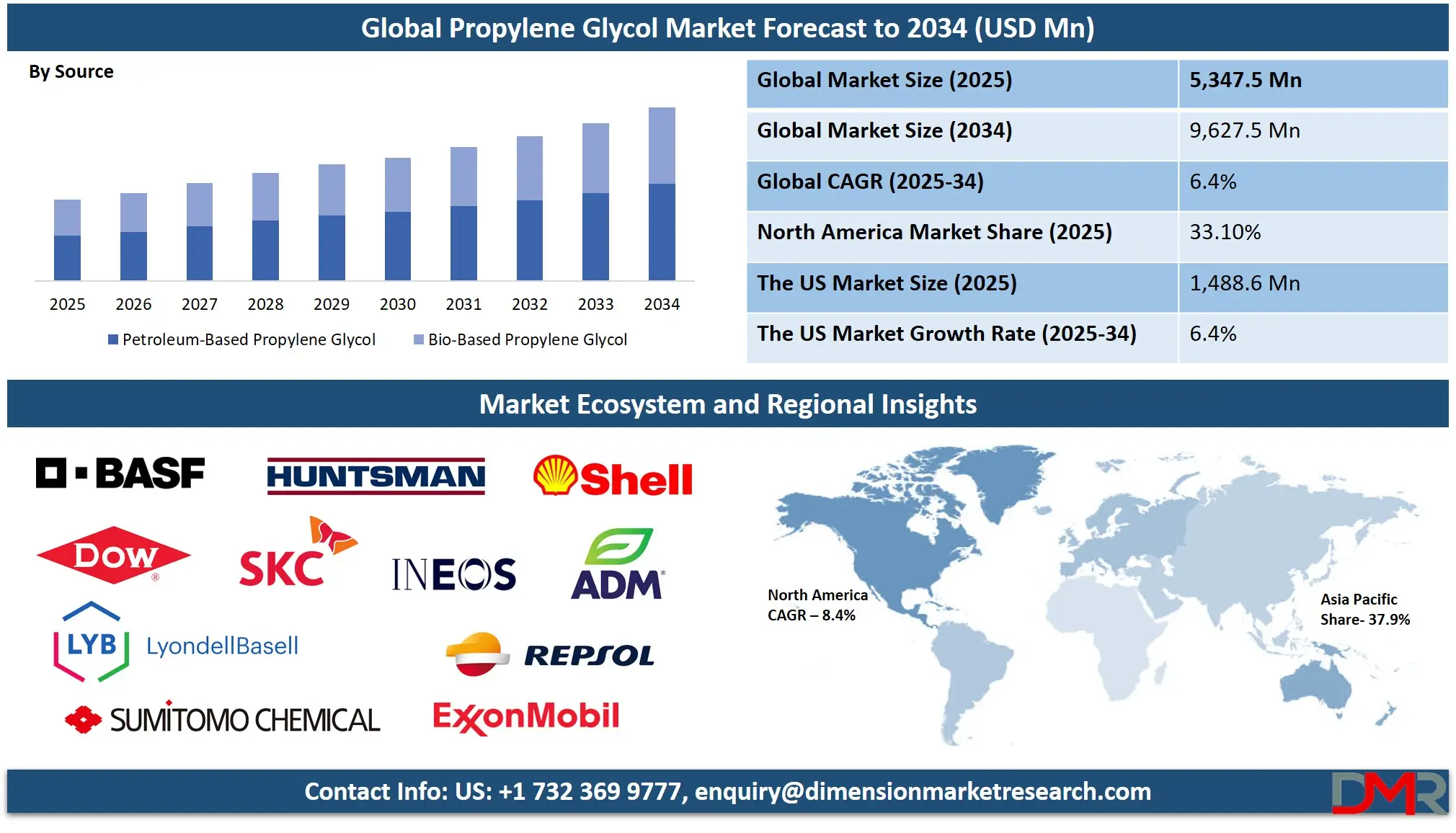
One of the most promising opportunities in the propylene glycol market is the increasing demand for eco-friendly and bio-based alternatives. Growing environmental regulations on petroleum-based derivatives have encouraged manufacturers to explore plant-based propylene glycol, particularly in pharmaceuticals, personal care, and food applications. The expansion of the electric vehicle (EV) market is also contributing to higher demand for coolants and heat transfer fluids, further enhancing the growth potential.
Despite strong growth, certain restraints hinder market expansion. Fluctuating raw material prices, especially those linked to petroleum-based feedstocks, pose a significant challenge to manufacturers. Additionally, regulatory hurdles concerning synthetic additives in pharmaceuticals and food applications create compliance complexities. The market also faces supply chain disruptions, which have been exacerbated by global economic fluctuations and trade restrictions.
The growth prospects for the propylene glycol market remain strong, with innovation playing a key role in driving new applications. Advancements in biotechnology and green chemistry are supporting the production of sustainable variants, while technological improvements in polymer and resin formulations enhance product performance in diverse industrial applications. Emerging economies, particularly in Asia-Pacific, present lucrative expansion opportunities due to rapid urbanization, increasing disposable income, and growing infrastructure investments.
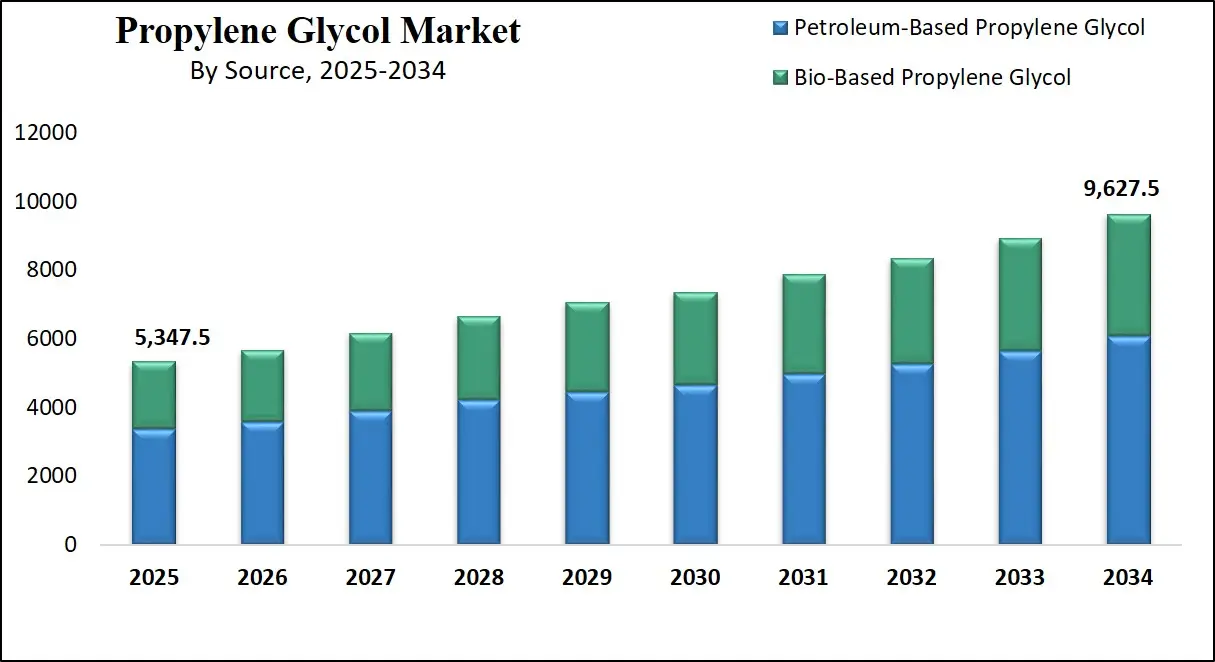
The US Propylene Glycol Market
The US Propylene Glycol Market is projected to be valued at USD 1,488.6 million in 2025. It is expected to witness subsequent growth in the upcoming period as it holds USD 2,599.0 million in 2034 at a CAGR of 6.4%.
The rising U.S. consumer demand for personal care and pharmaceutical products, as well as processed food products, creates an advantage for propylene glycol consumption. Electric vehicles now drive up the need for coolants and heat transfer fluids, causing major automakers to spend on thermal management solutions. The country experiences rapid growth of unsaturated polyester resins (UPR) for construction materials and marine applications, and automotive components because of its strong infrastructure sector. The rising market need for sustainable bio-based propylene glycol derivatives has prompted investments in their renewable manufacturing, while environmental safety regulations, together with sustainability goals of corporations, serve as main drivers in this development.
Biodegradable chemical policies, along with sustainable material support from government authorities, push market players to use bio-based alternatives in pharmaceuticals, cosmetics, and food processing. Dow, BASF, and LyondellBasell control the global propylene glycol market while continuing to improve their products through technological advancements for both effectiveness and ecological appeal. The U.S. aerospace industry demands high quantities of propylene glycol-based deicing fluids for plane maintenance operations. Extended technology innovations alongside regulatory support indicate the U.S. market will experience significant growth throughout the upcoming years.
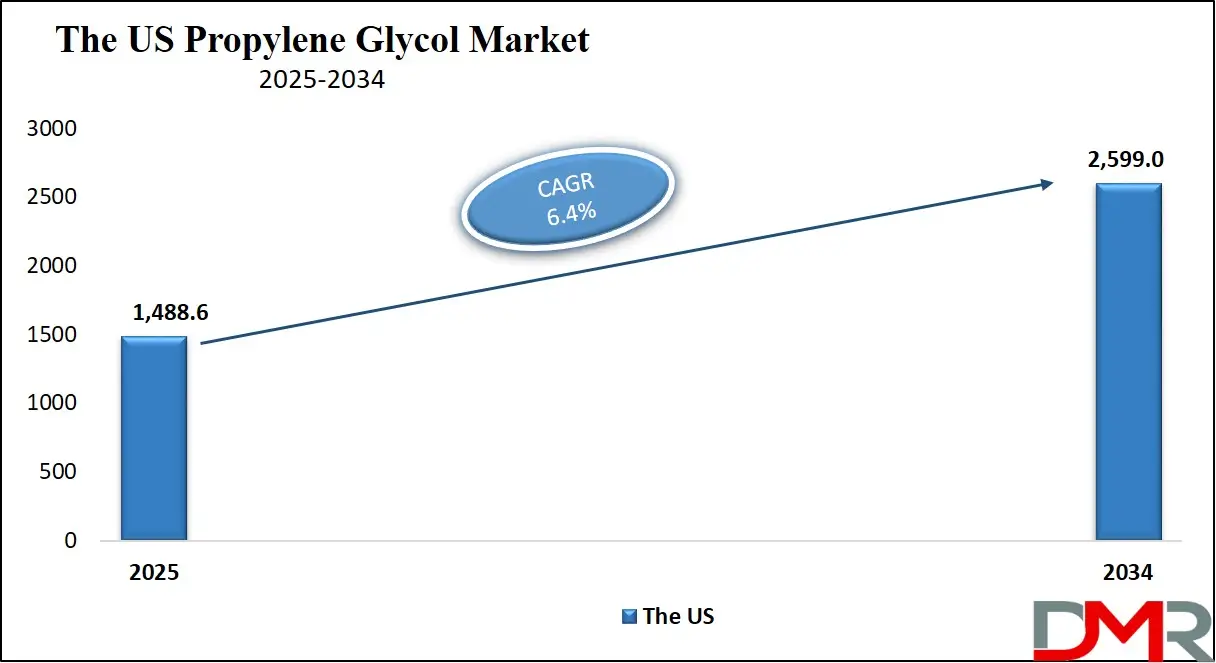
Global Propylene Glycol Market: Key Takeaways
- Global Market Size Insights: The Global Propylene Glycol Market size is estimated to have a value of USD 5,347.5 million in 2025 and is expected to reach USD 9,627.5 million by the end of 2034.
- The US Market Size Insights: The US Propylene Glycol Market is projected to be valued at USD 1,488.6 million in 2025. It is expected to witness subsequent growth in the upcoming period as it holds USD 2,599.0 million in 2034 at a CAGR of 6.4%.
- Regional Insights: Asia Pacific is expected to have the largest market share in the Global Propylene Glycol Market with a share of about 37.9% in 2025.
- Key Players: Some of the major key players in the Global Propylene Glycol Market are BASF SE, Dow Inc., LyondellBasell Industries Holdings B.V., Huntsman Corporation, SKC Co., and many others.
- The Global Growth Rate Insights: The market is growing at a CAGR of 6.8 percent over the forecasted period of 2025.
Global Propylene Glycol Market: Use Cases
- Automotive Coolants & Heat Transfer Fluids: The automotive sector together with industrial plants rely on propylene glycol as a coolant that helps achieve thermal control and protects systems from overheating. The rising use of electric vehicles expands the market requirement for advanced heat transfer fluids, which improves both automotive engine efficiency and battery operational performance.
- Food & Beverage Additives: The food industry uses propylene glycol as a humectant and stabilizer, and preservative, which appears in processed foods, together with bakery items and beverages. Propylene glycol supports the retention of product moisture, which enables longer shelf stability and improves the texture of consumables that follow FDA safety standards.
- Pharmaceutical & Personal Care Products: Pharmaceutical drug formulations use proprietary glycol as a stabilizing solution between the components of medicines available as both oral preparations and topical creams and injectables. The cosmetic industry utilizes propylene glycol as a moisturizer, which enhances both the consistency and hydration properties of deodorants and shampoos, along with lotions.
- Unsaturated Polyester Resins (UPR) for Construction: Fiberglass-reinforced plastics heavily rely on UPR-based products because they are essential components for construction materials and marine coatings, and automotive parts. The market requires infrastructure development due to the durability and resistance properties combined with improved mechanical capabilities of UPR-based resins.
- Aerospace & Defense Applications: The aviation industry requires propylene glycol as a major ingredient in deicing fluids to maintain flight safety during adverse weather operations. The aviation sector depends on propylene glycol to stop ice formation on aircraft surfaces, which protects against safety hazards during landing and takeoff operations.
Global Propylene Glycol Market: Stats & Facts
- According to OICA (2022), global automotive vehicle production reached 85.02 million units, reflecting a 6% YoY increase, with China, the U.S., and India leading, which in turn drives the demand for propylene glycol-based automotive fluids.
- OICA (2022) reports that U.S. vehicle production grew by 9%, reaching 10.06 million units, reinforcing the country’s strong automotive industry, which fuels the demand for propylene glycol in coolants and antifreeze solutions.
- Boeing Commercial Outlook (2023-2042) projects that the global commercial jet fleet will nearly double, reaching 42,595 aircraft, escalating the demand for propylene glycol-based deicing and thermal management fluids in aviation.
- Airbus (2022) disclosed that it delivered 661 commercial aircraft and received 1,078 new orders, while Boeing secured 57 orders for its 737 Max 8, reinforcing the importance of propylene glycol in aerospace applications.
- China Construction Market Report (2023) highlights that China, as the largest construction market globally, plans to invest USD 13 trillion by 2030, significantly boosting propylene glycol consumption in construction materials.
- The Indian Government Housing Report (2023) states that India’s housing sector will attract USD 1.3 trillion over seven years, leading to an increased application of propylene glycol in insulation and coatings.
- According to the China National Light Industry Council (2022), the food and beverage market in China recorded USD 1.53 trillion in revenue, growing by 5.6% YoY, which has fueled the demand for food-grade propylene glycol in processed foods.
- China Construction Market Report (2023) indicates that 20% of all global construction investments are in China, expanding the use of propylene glycol in adhesives, paints, and sealants for infrastructure projects.
- The Indian Government Housing Report (2023) projects that affordable housing in India will increase by 70% by 2024, accelerating the adoption of propylene glycol in construction materials and HVAC systems.
- China National Light Industry Council (2022) reveals that the rising demand for dairy-based products, soft drinks, and frozen desserts in China is driving propylene glycol consumption in food additives and flavoring agents.
Global Propylene Glycol Market: Market Dynamics
Driving Factors in the Global Propylene Glycol Market
Increasing Demand from the Construction and Automotive Sectors
The manufacturing of composite materials and reinforced plastics, and coatings through unsaturated polyester resins depends significantly on propylene glycol in the construction industry. The demand for propylene glycol-based resins increases because of fast urban growth alongside infrastructure works and rising investments in lightweight and corrosion-resistant durable materials. Propylene glycol enables the automotive industry to function through coolants and deicing fluids as well as brake fluids, thus fueling market expansion. The growth of automobile manufacturing throughout regions within Asia-Pacific and North America creates a strong demand for automotive applications based on propylene glycol.
Rising Demand for Pharmaceutical and Personal Care Products
The pharmaceutical sector, along with the personal care industry, consumes propylene glycol for its roles as a solvent and stabilizer and its properties to retain moisture within formulations. The healthcare sector expansion, together with rising interest in hygiene practices and escalating requirements for dermatological treatments and cosmetic products, drives propylene glycol consumption upwards. People widely choose propylene glycol for medications, whether taken by mouth, injected, or applied to the skin, since it exhibits non-harmful and safe behavior when in contact with skin. The market continues to grow because consumers choose bio-based propylene glycol over other ingredients due to its environmentally friendly character and safe qualities.
Restraints in the Global Propylene Glycol Market
Fluctuations in Raw Material Prices and Supply Chain Disruptions
Crude oil price volatility, along with unstable petroleum feedstock costs, determines how much it costs producers to manufacture propylene glycol. Renewable propylene glycol remains exposed to price changes in global petroleum markets and geopolitical events that disrupt raw material supply chains. Manufacturer operations face rising costs as well as production delays because of supply-chain vulnerabilities that emerged during the COVID-19 outbreak and through trade barriers alongside geopolitical disputes. The production of renewable propylene glycol depends on glycerin as a bio-based feedstock; thus, any disruption in its supply affects both market stability and the bio-polymer industry.
Stringent Regulations and Environmental Concerns
The FDA (Food and Drug Administration), together with the EPA (Environmental Protection Agency) and European Chemicals Agency (ECHA), establishes rigid rules for propylene glycol utilization in medical products, foodstuffs, and cosmetic items. Manufacturers face barriers in complying with safety standards, together with labeling requirements and synthetic additive limitations, especially when operating within highly regulated markets, including North America and Europe. Manufacturers now spend more money on extensive testing, along with quality control and sustainable alternatives, because synthetic propylene glycol triggers increased market compliance scrutiny in specific applications.
Opportunities in the Global Propylene Glycol Market
Expansion of Sustainable and Renewable Propylene Glycol Production
The manufacturer sector invests funding into bio-based propylene glycol development due to growing demands for fossil fuel exhaustion alongside environmental sustainability needs. The initiatives for sustainability from both government entities and corporations continue to fuel investments toward renewable chemical manufacturing. BASF, alongside Dow Corporation, plans to increase its green propylene glycol manufacturing capabilities to decrease its use of fossil fuel source materials. The market transformation toward green chemistry and circular economy practices gives existing players opportunities to compete in growing sectors focused on sustainable alternatives, which are both non-toxic and biodegradable.
Growing Industrial Applications and Emerging Markets
The developing economies of India, China, and Brazil provide substantial market prospects because of their expanding industrial sectors. The market expansion of propylene glycol materials continues to grow due to quick industrial growth combined with higher disposable income levels and expanding infrastructure developments. The aerospace and defense industry expansion creates escalating demand for propylene glycol-based deicing fluids and hydraulic fluids. Numerous industries benefit from increasing market potential because of emerging biotech and food processing, and advanced cooling system applications.
Trends in the Global Propylene Glycol Market
Rising Adoption of Bio-Based Propylene Glycol
The market has begun a major transition toward bio-based propylene glycol because sustainability objectives alongside government regulation requirements support the implementation of eco-friendly chemicals. Modern industries move away from petroleum-based propylene glycol to more sustainable alternatives, which come from renewable sources like glycerin and sugars obtained from corn.
Two of the leading companies, Archer Daniels Midland (ADM) and BASF, use substantial financial resources to develop bio-based production methods for sustainable product solutions. The pharmaceutical industry and personal care products segment, along with food additives now require bioactive non-hazardous components, thus driving this market shift. The attractiveness of bio-based propylene glycol increases because it helps lower carbon emissions while meeting extensive environmental requirements across multiple industries.
Expanding Use in Electric Vehicles (EVs) and Advanced Cooling Applications
Both electric vehicles (EVs) and hybrid vehicles push forward the rising market need for propylene glycol-based coolants and heat transfer fluids. The growing demand for efficient thermal management solutions in electric vehicles creates ongoing high-performance coolant demand because EVs need temperature maintenance solutions and performance enhancement, as well as overheating prevention. Commercial use of propylene glycol continues to grow because it finds application in both data center operations and industrial cooling systems and HVAC installations. Industrial developments in propylene glycol-based heat transfer fluids focus on improved thermal stability and anti-corrosion properties because of growing worldwide energy efficiency and sustainability requirements for cooling solutions.
Global Propylene Glycol Market: Research Scope and Analysis
By Source Analysis
Petroleum-based propylene glycol is projected to lead the global market because of its cost-effective production, along with abundant supply and established manufacturing procedures. The propylene glycol variant manufactured by petroleum refining propylene oxide products serves as the industrial standard because it benefits from large-scale production and extensive industrial uses for decades. Its affordable manufacturing price establishes petroleum-based propylene glycol as the primary material of choice when industry concentration on costs occurs, like in automotive applications and construction and pharmaceuticals, and food production. At present, petroleum feedstocks maintain a dependable supply chain that allows bulk producers to execute orders safely without encountering feedstock irregularities or price volatility.
The extensive dominance of petroleum-based propylene glycol stems from exceptional chemical durability along with outstanding operational attributes. Petroleum-derived propylene glycol demonstrates high thermal stability together with low viscosity and powerful solvent capabilities, which align it perfectly for heat transfer fluids and deicing solutions and unsaturated polyester resins (UPR).
The durability properties of petroleum-based products make them essential for extended-lasting formulations that serve industries like construction as well as aerospace and industrial manufacturing. Petroleum-based variants successfully pass strict safety regulations while their established safety track record makes manufacturers continue to select them.
The rise of bio-based propylene glycol happens because of sustainability needs, yet its production costs challenge widespread adoption, and its ability to scale up production remains restricted. The existing worldwide facilities built to refine petroleum and process chemicals ensure that petroleum-based propylene glycol will stay prominent in the market. Industries will keep selecting petroleum-based propylene glycol since bio-based alternatives need to achieve lower prices along with broader distribution before replacing this leading chemical.
By Grade Analysis
Industrial-grade propylene glycol is poised to control this market through its broad applicability, along with economical production and its wide implementation across construction sites, automotive operations, and chemical industrial operations. Because industrial-grade propylene glycol lacks the same regulatory requirements as pharmaceutical and food-grade versions, it provides better economic value for industrial-scale deployment. Industries opt for industrial-grade propylene glycol due to its budget-friendliness to satisfy their large-scale functional requirements, instead of human dietary consumption. Industrial-grade propylene glycol rules industries because it serves as the main ingredient in unsaturated polyester resins (UPR), which enable reinforced plastics manufacture along with fiberglass composites and coatings, and adhesives production.
The construction sector, together with automotive manufacturing sectors, creates high industrial demand for UPR-based materials, which requires considerable amounts of industrial-grade propylene glycol. The leading position of this chemical results from its diverse applications in heat transfer fluids for aerospace and transportation, as well as antifreeze solutions and deicing applications. The applications need a high-performing material that is both chemically stable and offers cost-effective operation, which industrial-grade propylene glycol effectively delivers.
The manufacturing process and distribution of industrial-grade propylene glycol remain straightforward because pharmaceutical and food-grade standards for purification do not apply. Mass production of industrial-grade propylene glycol becomes possible because stringent quality control requirements decrease which enabling suppliers to meet worldwide market needs effectively. Industrial-grade propylene glycol will sustain its position as the leading market segment because developing economies want it to support their industry expansions through ongoing industrialization and infrastructure development.
By Application Analysis
Unsaturated polyester resins (UPR) is expected to control the market demand for propylene glycol because these resins maintain crucial positions within construction development and automotive production, as well as the marine sector, alongside industrial manufacturing processes. The usage of UPRs extends to fiberglass-reinforced plastics as well as composites and coatings, and adhesives, where strength combined with durability and chemical resistance are requirements for these products. The automotive and aerospace industries are driving up the use of UPR-based products due to their rising need for lightweight corrosion-resistant materials.
UPR stands as the most dominant propylene glycol application because it is extensively used throughout the construction industry. UPR-based composites find extensive use as weather-resistant materials in roofing panels and doors and windows, and reinforced concrete structures because they provide excellent durability. The fast pace of urbanization, combined with growing infrastructure development activities, specifically in developing economies, drives the consumption of UPR.
The automotive industry advances toward lightweight materials, which drives consumption at the forefront. The utilization of UPR-based composites enables weight reduction of vehicles while improving both fuel economy and safety characteristics, thus making them the top material choice for automotive assembly applications, including body panels and bumpers, and structural elements. UPRs serve marine purposes in boat hulls along with decks and corrosion-resistant coatings, thanks to their resistance nature toward harsh marine environments. The expanding markets of construction, together with transportation and marine manufacturing, maintain robust demand for UPR-based materials that strengthen UPR as a leading option in propylene glycol applications.
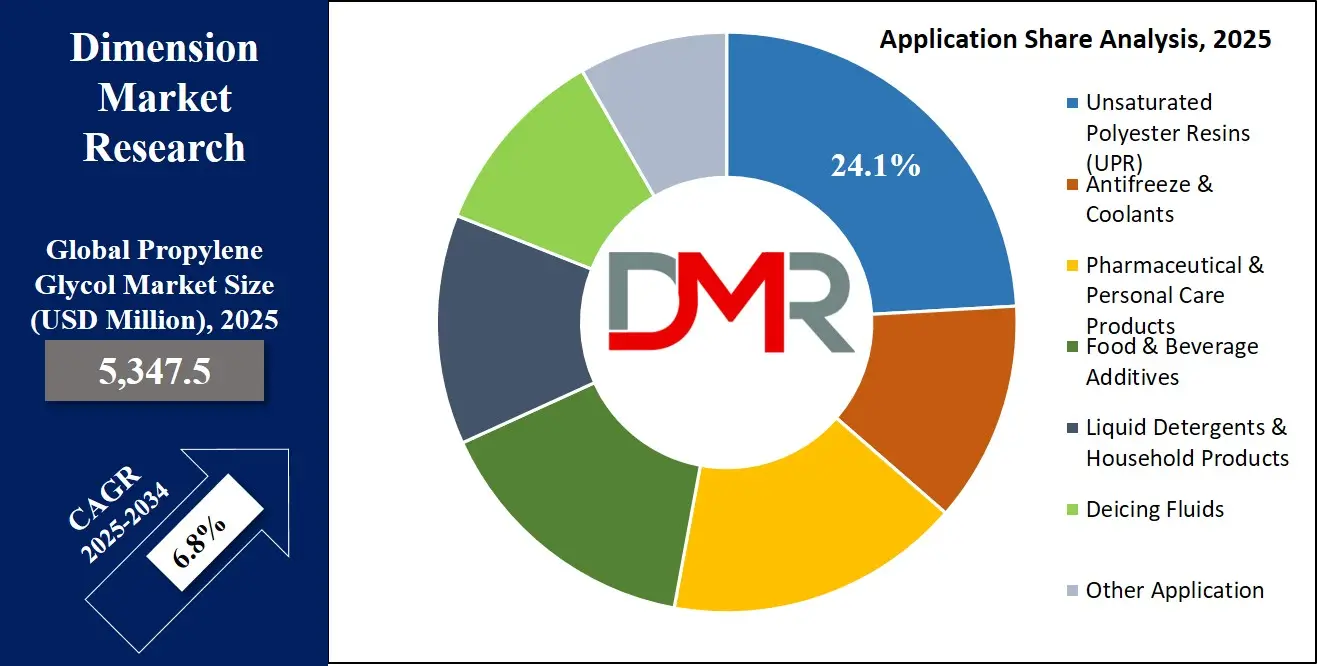
By End-User Analysis
The propylene glycol market is projected to show dominance by the automotive and transportation sector because this sector uses substantial quantities in coolants along with antifreeze and deicing fluids, and brake fluids. The essential role of propylene glycol exists in engine coolants and heat transfer fluids because they control vehicle temperatures while stopping overheating.
The automotive sector requires high-performance cooling solutions because vehicle production increases globally, along with the growing adoption of electric vehicles, so propylene glycol continues to be essential for the industry. The automotive sector remains dominant mainly because propylene glycol-based antifreeze serves as its primary dependency. Vehicle owners operating in cold regions must employ antifreeze solutions because these substances minimize engine freezing while enhancing operating performance. Automobile manufacturers use propylene glycol-based coolants at a higher priority over ethylene glycol-based brands because they offer superior environmental protection and less toxicity, which makes them suitable for industrial and personal transportation. Electrical Vehicle (EV) battery systems adopt advanced thermal management fluids that strengthen the market need for propylene glycol-based heat transfer fluids.
Within the transportation sector, propylene glycol functions as an essential component in deicing fluids that keep planes operational by clearing aircraft and runways during maintenance and deicing procedures. The worldwide combination of airlines and airports implements propylene glycol-based deicing solutions as part of their operations to maintain safety during winter takeoffs and landings. Safety regulations and a surge in flying operations within the aerospace industry work together to make propylene glycol a leading choice for this sector. Propylene glycol maintains its dominance in the end-user segment because the automotive industry continues to develop solutions for thermal management and deicing, and vehicle maintenance, while focusing on sustainable and efficient operations.
The Global Propylene Glycol Market Report is segmented on the basis of the following:
By Source
- Petroleum-Based Propylene Glycol
- Bio-Based Propylene Glycol
By Grade
- Industrial Grade
- Pharmaceutical Grade
- Food Grade
By Application
- Unsaturated Polyester Resins (UPR)
- Antifreeze & Coolants
- Pharmaceutical & Personal Care Products
- Food & Beverage Additives
- Liquid Detergents & Household Products
- Deicing Fluids
- Other Application
By End-user
- Automotive & Transportation
- Building & Construction
- Pharmaceuticals & Healthcare
- Food & Beverages
- Cosmetics & Personal Care
- Chemical & Industrial Processing
- Aerospace & Defense
- Textile & Leather Industry
Global Propylene Glycol Market: Regional Analysis
Region with Highest Market Share
Asia-Pacific is projected to lead the global propylene glycol market with 37.9% market share by 2025 due to its extensive industrial base, expanding manufacturing sector, and rapidly growing infrastructure development. China, India, Japan and South Korea are home to some of the biggest chemical manufacturing hubs that produce and consume propylene glycol globally; construction industries across these nations are rapidly growing as is pharmaceutical use which necessitates supplies of unsaturated polyester resins (UPR), antifreeze solutions and personal care products which all rely on propylene glycol as key ingredients in their formulations driving demand even further in these nations for product containing propylene glycol as core ingredients.
Asia-Pacific's automotive sector, propelled by high vehicle production rates in China, India, and Japan, has created strong demand for coolants, deicing fluids, lubricants, and antifreeze, further consolidating Asia-Pacific's leadership position. Furthermore, rising disposable incomes combined with urbanization have spurred rapid expansion within food, beverage, cosmetic, and pharmaceutical industries, fuelling an upsurge in propylene glycol needs across these fields. The presence of major market players, low production costs, and easy availability of raw materials further solidify Asia-Pacific as the leader within global propylene glycol markets.
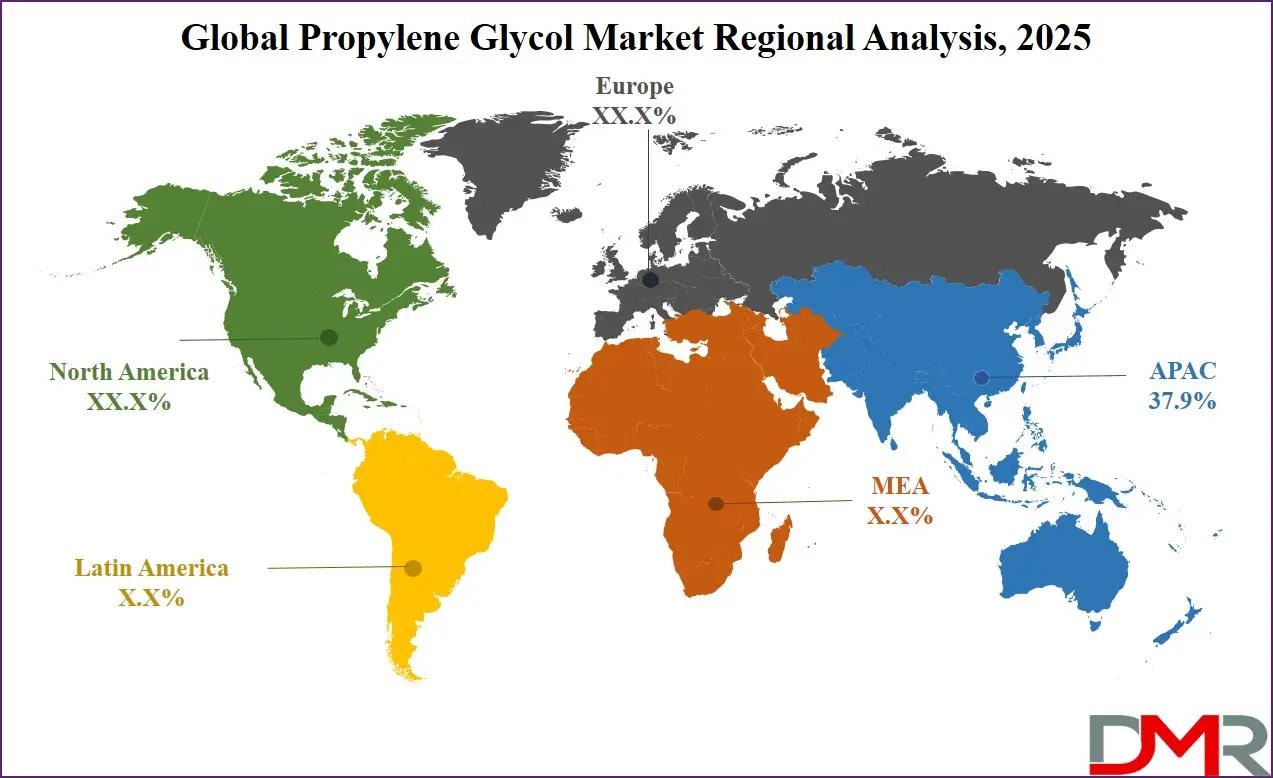
Region with Highest CAGR
North America is currently witnessing highest compound annual growth rates for propylene glycol markets worldwide due to rising bio-based propylene glycol demand, advancements in chemical processing technologies, and rising environmental regulations. Both North America countries are leading in adopting eco-friendly alternatives resulting in rapid increases in both production and consumption of bio-based propylene glycol production and consumption rates. With stricter regulations on petroleum-based chemicals being phased out of use by industries, businesses in this region have increasingly adopted sustainable solutions as green alternatives have taken their place, driving market expansion forward.
Strong pharmaceutical, personal care, and food & beverage companies in North America have led to high demand for pharmaceutical-grade and food-grade propylene glycol, especially from aviation and transportation applications. Furthermore, North America's cold climate contributes significantly towards antifreeze/deicing fluid demand, which fuels ongoing investments in research & development, coupled with rising specialty chemical needs, are likely to accelerate North America's rapid market expansion, making North America the fastest growing region within propylene glycol's global market.
By Region
North America
Europe
- Germany
- The U.K.
- France
- Italy
- Russia
- Spain
- Benelux
- Nordic
- Rest of Europe
Asia-Pacific
- China
- Japan
- South Korea
- India
- ANZ
- ASEAN
- Rest of Asia-Pacific
Latin America
- Brazil
- Mexico
- Argentina
- Colombia
- Rest of Latin America
Middle East & Africa
- Saudi Arabia
- UAE
- South Africa
- Israel
- Egypt
- Rest of MEA
Global Propylene Glycol Market: Competitive Landscape
The global propylene glycol market is highly competitive, with key players focusing on capacity expansions, strategic acquisitions, and technological advancements to strengthen their market position. Major companies such as BASF SE, Dow Inc., LyondellBasell Industries Holdings B.V., and Huntsman Corporation dominate the industry with large-scale production facilities and a strong global distribution network. These companies are investing in bio-based propylene glycol production to align with sustainability trends and regulatory compliance.
Additionally, Asian players like Sumitomo Chemical Co., Ltd., SKC Co., Ltd., and Manali Petrochemicals Limited are expanding their manufacturing capacities to cater to the growing demand in Asia-Pacific. Companies are also engaging in partnerships and acquisitions to enhance their market reach. For instance, leading firms are collaborating with automotive and pharmaceutical companies to provide customized solutions for heat transfer fluids, antifreeze, and personal care applications.
With the rising emphasis on sustainability, companies such as Archer Daniels Midland Company (ADM) and Global Bio-Chem Technology Group Co., Ltd. are focusing on bio-based propylene glycol production, posing strong competition to traditional petroleum-based manufacturers. This dynamic competitive landscape is expected to drive further innovation and market expansion.
Some of the prominent players in the Global Propylene Glycol Market are:
- BASF SE
- Dow Inc.
- LyondellBasell Industries Holdings B.V.
- Huntsman Corporation
- SKC Co., Ltd.
- Shell plc
- INEOS Group
- Archer Daniels Midland Company (ADM)
- Repsol S.A.
- Sumitomo Chemical Co., Ltd.
- Asahi Glass Co., Ltd. (AGC Inc.)
- ExxonMobil Corporation
- Royal Dutch Shell plc
- Global Bio-Chem Technology Group Co., Ltd.
- Temix Oleo S.R.L.
- Qingdao Shida Chemical Co., Ltd.
- ADEKA Corporation
- Manali Petrochemicals Limited
- OXEA GmbH
- Saudi Basic Industries Corporation (SABIC)
- Other Key Players
Recent Developments in the Global Propylene Glycol Market
March 2024
- Dow Introduces Sustainable Propylene Glycol Variants: Dow unveiled two new propylene glycol formulations in North America, Propylene Glycol CIR and Propylene Glycol REN, derived from bio-circular and circular feedstocks. These innovations aim to reduce reliance on fossil-based resources and cater to industries such as personal care and agriculture.
December 2023
- Brenntag Acquires Solventis Group: Brenntag, a global chemical distributor, acquired Solventis Group, enhancing its distribution capabilities in glycols and solvents across Europe. This strategic move aligns with Brenntag Essentials' goal to strengthen its network and logistical footprint.
November 2023
- Dow and Evonik Launch Sustainable Pilot Plant: Dow and Evonik inaugurated a pilot plant in Hanau, Germany, utilizing the innovative Hyprosyn method for the direct synthesis of propylene glycol from propylene and hydrogen peroxide. This initiative underscores their commitment to sustainable chemical production.
September 2023
- Dow Introduces Bio-Based Propylene Glycol in Europe: Dow expanded its portfolio by introducing circular, bio-based, and low-carbon propylene glycol solutions across Europe. These products are versatile, catering to industries including food, textiles, pharmaceuticals, cosmetics, and agriculture.
May 2023
- ORLEN Poludnie's BioPG Facility Completes First Year: ORLEN Poludnie celebrated the first year of operation of its BioPG facility in Poland, which converts glycerol, a biodiesel by-product, into environmentally friendly propylene glycol. This achievement highlights the potential of sustainable production methods in the chemical industry.
March 2023
- LyondellBasell Acquires Mepol Group: LyondellBasell agreed to acquire Mepol Group, a manufacturer of recycled, high-performance technical compounds in Italy and Poland. This acquisition enhances LyondellBasell's capabilities in sustainable materials.
Report Details
| Report Characteristics |
| Market Size (2025) |
USD 5,347.5 Mn |
| Forecast Value (2034) |
USD 9,627.5 Mn |
| CAGR (2025–2034) |
6.8% |
| Historical Data |
2019 – 2024 |
| The US Market Size (2025) |
USD 1,488.6 Mn |
| Forecast Data |
2025 – 2033 |
| Base Year |
2024 |
| Estimate Year |
2025 |
| Report Coverage |
Market Revenue Estimation, Market Dynamics, Competitive Landscape, Growth Factors, etc. |
| Segments Covered |
By Source (Petroleum-Based, Bio-Based), By Grade (Industrial, Pharmaceutical, Food), By Application (Unsaturated Polyester Resins, Antifreeze & Coolants, Pharmaceutical & Personal Care, Food & Beverage Additives, Liquid Detergents & Household Products, Deicing Fluids, Others), and By End-User (Automotive & Transportation, Building & Construction, Pharmaceuticals & Healthcare, Food & Beverages, Cosmetics & Personal Care, Chemical & Industrial Processing, Aerospace & Defense, Textile & Leather Industry) |
| Regional Coverage |
North America – US, Canada;
Europe – Germany, UK, France, Russia, Spain, Italy, Benelux, Nordic, Rest of Europe;
Asia-Pacific – China, Japan, South Korea, India, ANZ, ASEAN, Rest of APAC;
Latin America – Brazil, Mexico, Argentina, Colombia, Rest of Latin America;
Middle East & Africa – Saudi Arabia, UAE, South Africa, Turkey, Egypt, Israel, Rest of MEA
|
| Prominent Players |
BASF SE, Dow Inc., LyondellBasell Industries Holdings B.V., Huntsman Corporation, SKC Co., Ltd., Shell plc, INEOS Group, Archer Daniels Midland Company (ADM), Repsol S.A., Sumitomo Chemical Co., Ltd., Asahi Glass Co., Ltd. (AGC Inc.), ExxonMobil Corporation, Royal Dutch Shell plc, Global Bio-Chem Technology Group Co. Ltd., Temix Oleo S.R.L., Qingdao Shida Chemical Co., Ltd., ADEKA Corporation, Manali Petrochemicals Limited, OXEA GmbH, and Saudi Basic Industries Corporation (SABIC)., and Other Key Players |
| Purchase Options |
We have three licenses to opt for: Single User License (Limited to 1 user),
Multi-User License (Up to 5 Users), and
Corporate Use License (Unlimited User) along with free report customization equivalent to
0 analyst working days, 3 analysts working days, and 5 analysts working days respectively.
|
Frequently Asked Questions
The Global Propylene Glycol Market size is estimated to have a value of USD 5,347.5 million in 2025 and is expected to reach USD 9,627.5 million by the end of 2034.
The US Propylene Glycol Market is projected to be valued at USD 1,488.6 million in 2025. It is expected to witness subsequent growth in the upcoming period as it holds USD 2,599.0 million in 2034 at a CAGR of 6.4%.
Asia Pacific is expected to have the largest market share in the Global Propylene Glycol Market with a share of about 37.9% in 2025.
Some of the major key players in the Global Propylene Glycol Market are BASF SE, Dow Inc., LyondellBasell Industries Holdings B.V., Huntsman Corporation, SKC Co., and many others.
The market is growing at a CAGR of 6.8 percent over the forecasted period of 2025.